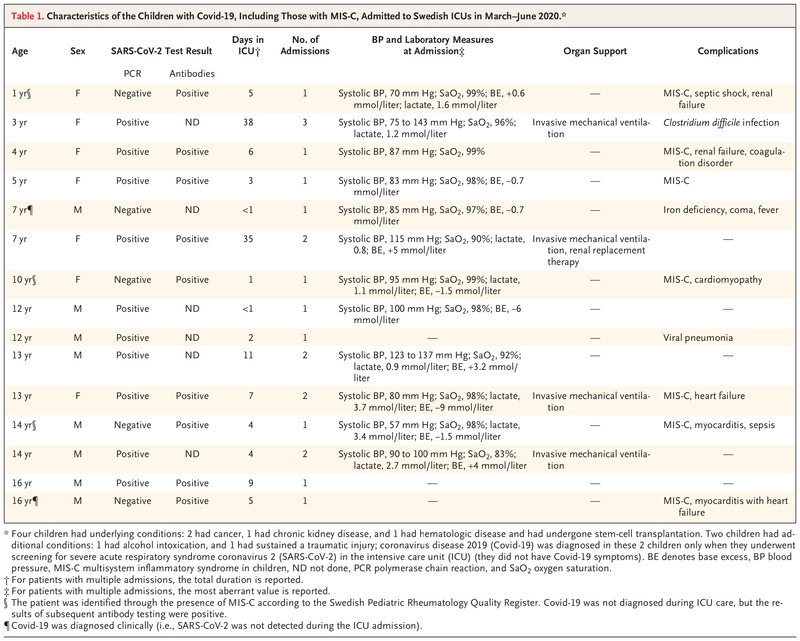Estudio realizado del 1 de marzo al 30 de junio, y publicado en la New England Journal Medicine (NEJM):
De 1.951.905 niños de 1 a 16 años:
– 15 visitas a la UCI, 0 muertes por Covid.
– Los profesores NO tuvieron más visitas a la UCI que otras profesiones.
– Colegios abiertos a tiempo completo y sin mascarilla.
In mid-March 2020, many countries decided to close schools in an attempt to limit the spread of severe acute respiratory syndrome coronavirus 2 (SARS-CoV-2), the virus causing coronavirus disease 2019 (Covid-19).1,2 Sweden was one of the few countries that decided to keep preschools (generally caring for children 1 to 6 years of age) and schools (with children 7 to 16 years of age) open. Here, we present data from Sweden on Covid-19 among children 1 to 16 years of age and their teachers. In Sweden, Covid-19 was prevalent in the community during the spring of 2020.3 Social distancing was encouraged in Sweden, but wearing face masks was not.3
Data on severe Covid-19, as defined by intensive care unit (ICU) admission, were prospectively recorded in the nationwide Swedish intensive care registry. We followed all children who were admitted to an ICU between March 1 and June 30, 2020 (school ended around June 10) with laboratory-verified or clinically verified Covid-19, including patients who were admitted for multisystem inflammatory syndrome in children (MIS-C, which is likely to be related to Covid-19)4 according to the Swedish Pediatric Rheumatology Quality Register. (More information on the registry and a link to the World Health Organization scientific brief on MIS-C are provided in the Supplementary Appendix, available with the full text of this letter at NEJM.org.) The Stockholm Ethics Review Board approved the study. Informed consent was waived by the review board. Table 1.

Characteristics of the Children with Covid-19, Including Those with MIS-C, Admitted to Swedish ICUs in March–June 2020.
The number of deaths from any cause among the 1,951,905 children in Sweden (as of December 31, 2019) who were 1 to 16 years of age was 65 during the pre–Covid-19 period of November 2019 through February 2020 and 69 during 4 months of exposure to Covid-19 (March through June 2020) (see the Supplementary Appendix). From March through June 2020, a total of 15 children with Covid-19 (including those with MIS-C) were admitted to an ICU (0.77 per 100,000 children in this age group) (Table 1), 4 of whom were 1 to 6 years of age (0.54 per 100,000) and 11 of whom were 7 to 16 years of age (0.90 per 100,000). Four of the children had an underlying chronic coexisting condition (cancer in 2, chronic kidney disease in 1, and hematologic disease in 1). No child with Covid-19 died.
Data from the Public Health Agency of Sweden (published report5 and personal communication) showed that fewer than 10 preschool teachers and 20 schoolteachers in Sweden received intensive care for Covid-19 up until June 30, 2020 (20 per 103,596 schoolteachers, which is equal to 19 per 100,000). As compared with other occupations (excluding health care workers), this corresponded to sex- and age-adjusted relative risks of 1.10 (95% confidence interval [CI], 0.49 to 2.49) among preschool teachers and 0.43 (95% CI, 0.28 to 0.68) among schoolteachers (see the Supplementary Appendix).
The present study had some limitations. We lacked data on household transmission of Covid-19 from schoolchildren, and the 95% confidence intervals for our results are wide.
Despite Sweden’s having kept schools and preschools open, we found a low incidence of severe Covid-19 among schoolchildren and children of preschool age during the SARS-CoV-2 pandemic. Among the 1.95 million children who were 1 to 16 years of age, 15 children had Covid-19, MIS-C, or both conditions and were admitted to an ICU, which is equal to 1 child in 130,000.
Jonas F. Ludvigsson, M.D., Ph.D.
Karolinska Institutet, Stockholm, Sweden
jonasludvigsson@yahoo.com
Lars Engerström, M.D., Ph.D.
Vrinnevi Hospital, Norrköping, Sweden
Charlotta Nordenhäll, M.D., Ph.D.
Swedish Association of Pediatric Rheumatology, Stockholm, Sweden
Emma Larsson, M.D., Ph.D.
Karolinska Institutet, Stockholm, Sweden
Disclosure forms provided by the authors are available with the full text of this letter at NEJM.org.
This letter was published on January 6, 2021, at NEJM.org.
Impactos: 179
